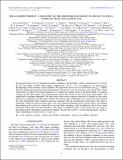THE K2-ESPRINT PROJECT. I. DISCOVERY OF THE DISINTEGRATING ROCKY PLANET K2-22b WITH A COMETARY HEAD AND LEADING TAIL
Author(s)
Dai, Fei; Winn, Joshua Nathan; Rappaport, Saul A; Yu, Liang
DownloadSanchis-Ojeda-2015-THE K2-ESPRINT PROJE.pdf (3.121Mb)
PUBLISHER_POLICY
Publisher Policy
Article is made available in accordance with the publisher's policy and may be subject to US copyright law. Please refer to the publisher's site for terms of use.
Terms of use
Metadata
Show full item recordAbstract
We present the discovery of a transiting exoplanet candidate in the K2 Field-1 with an orbital period of 9.1457 hr: K2-22b. The highly variable transit depths, ranging from ~0% to 1.3%, are suggestive of a planet that is disintegrating via the emission of dusty effluents. We characterize the host star as an M-dwarf with T[subscript eff] [~ over -] 3800 K. We have obtained ground-based transit measurements with several 1-m class telescopes and with the GTC. These observations (1) improve the transit ephemeris; (2) confirm the variable nature of the transit depths; (3) indicate variations in the transit shapes; and (4) demonstrate clearly that at least on one occasion the transit depths were significantly wavelength dependent. The latter three effects tend to indicate extinction of starlight by dust rather than by any combination of solid bodies. The K2 observations yield a folded light curve with lower time resolution but with substantially better statistical precision compared with the ground-based observations. We detect a significant "bump" just after the transit egress, and a less significant bump just prior to transit ingress. We interpret these bumps in the context of a planet that is not only likely streaming a dust tail behind it, but also has a more prominent leading dust trail that precedes it. This effect is modeled in terms of dust grains that can escape to beyond the planet's Hill sphere and effectively undergo "Roche lobe overflow," even though the planet's surface is likely underfilling its Roche lobe by a factor of 2.
Date issued
2015-10Department
Massachusetts Institute of Technology. Department of Physics; MIT Kavli Institute for Astrophysics and Space ResearchJournal
The Astrophysical Journal
Publisher
IOP Publishing
Citation
Sanchis-Ojeda, R., S. Rappaport, E. Palle, L. Delrez, J. DeVore, D. Gandolfi, A. Fukui, et al. “THE K2-ESPRINT PROJECT. I. DISCOVERY OF THE DISINTEGRATING ROCKY PLANET K2-22b WITH A COMETARY HEAD AND LEADING TAIL.” The Astrophysical Journal 812, no. 2 (October 14, 2015): 112. © 2015 The American Astronomical Society
Version: Final published version
ISSN
1538-4357
0004-637X